About
Chemistry is the study of the properties and behavior of matter and energy that affect nearly every aspect of our lives and environment. Biochemistry encompasses the study of the form and function of the proteins, lipids, carbohydrates, and nucleic acids found in living organisms.
Chemistry
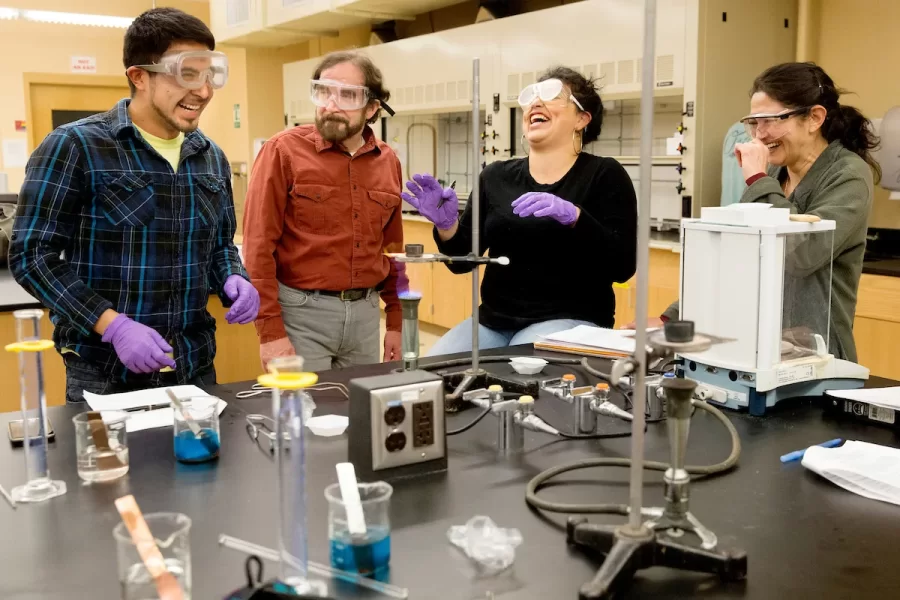
Chemistry deals with phenomena that affect nearly every aspect of our lives and environment. A liberal arts education in this scientific and technological age exposes students to the theories, laws, applications, and potential of this science.
The chemistry curriculum is sufficiently flexible to allow students with career interests in areas such as the health professions, law, business, and education to design a major program suitable to their goals. Students interested in careers in chemistry or biochemistry will find sufficient chemistry electives to provide a strong background for work in graduate school, industry, or other positions. The department and its curriculum are approved by the American Chemical Society (ACS), and an ACS-certified major is offered.
Biochemistry
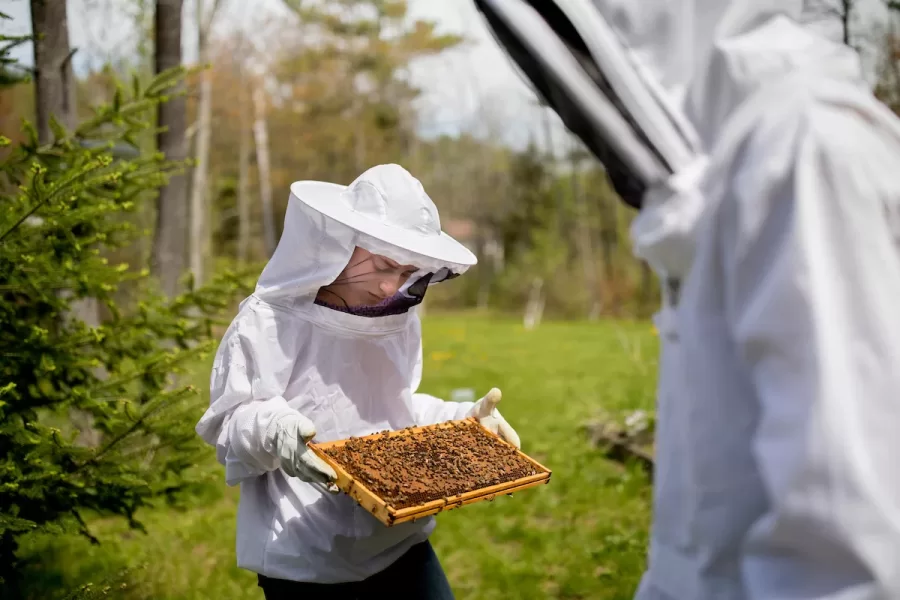
Biochemistry encompasses the study of the form and function of the proteins, lipids, carbohydrates, and nucleic acids found in living organisms.
Traditionally, biochemistry has been an interdisciplinary field, drawing on techniques and expertise from physics, medicine, biology, and chemistry. The required courses for the major give a student a solid foundation in basic science, while the array of elective courses allows wide latitude in pursuing an area of individual interest. The thesis provides a final integrating experience.
The program maintains affiliations with certain research laboratories at which students may conduct a semester of research for credit. Such credits may be used to fulfill one of the elective requirements or a portion of the thesis requirement; however, such a possibility must be arranged by the student prior to beginning the research program.
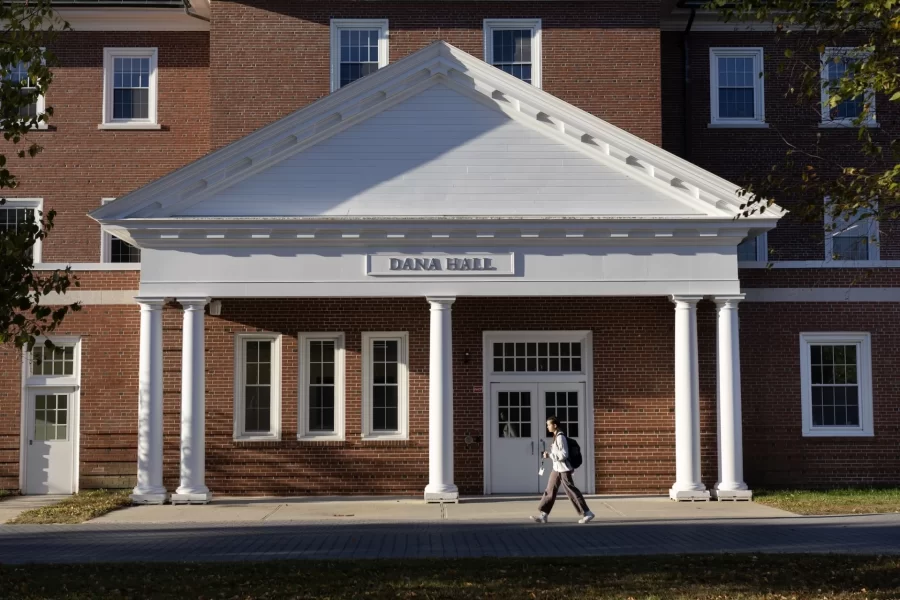
Campus scenes from Oct. 11, 2024. Students pass by Dana Chemistry on Alumni Walk.
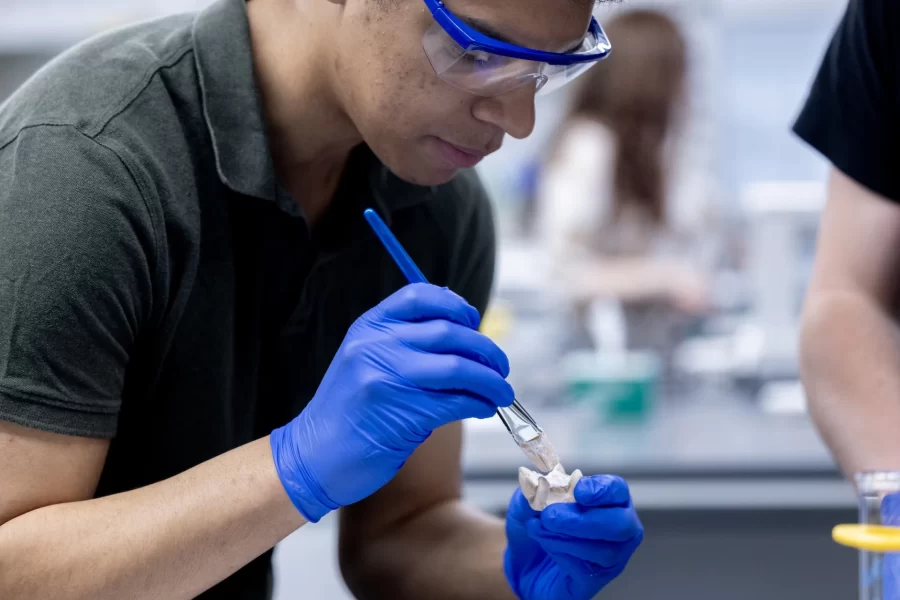
They are jumping for joy. Women’s varsity rowing teammates Oli Seline ’24 (left) of Delaware, Ohio, and Olivia Dekker ’24 of Bethesda, Md., high five it at the conclusion of their last-ever Bates lab in Bonney 360. The teammates are students in Assistant Professor of Biochemistry Geneva Laurita’s Short Term course, “Chemistry and the Arts.” Seline is a biochemistry major with a GEC in “Visible Ideas,” while Dekker is a biochemistry major with a minor in art and visual culture. The course explores the connection between chemistry and various topics in the arts and arts-related fields. The students learn about the chemistry behind these topics, exploring the literature behind various artistic practices, and applying hands-on techniques in the laboratory involved in various art processes This year, Laurita asked students to focus on the origins of color, different crafts, print making, jewelry making, dyeing, and art conservation. Laurita is the recipient of a major National Science Foundation grant of $581,984. The NSF CAREER award, considered to be one of the foundation’s most prestigious awards for faculty members who are just beginning their teaching and research careers, is based on both her scientific research in solid state materials and how she brings undergraduates into that vital area of scientific exploration. 3:18 What the particular lab was about…the lab handout. Kate Baumler, intern for Geneva’s NSF grant, wearing, black shirt Benji Richards, ’27, wearing tan shirt Finian Gunny ’27, gray pullover and blond hair Charlotte Maffie ’25 with pink tie dyed and hair in bun Sister Alice Maffie ’27 in t-shirt and pony tail Nina Greeley ’24 with hair in bun and pink t-shirt Riley Lund ’26 in gray sweatshirt Jahan Baker-Wainwright ’25 in green golf Rohini Kandasamy ’27 in dark tan Life is cool t-shirt and low bun Chemistry and the Arts S28, the origin of different crafts, print making, jewelry making, dyeing and art soncserv
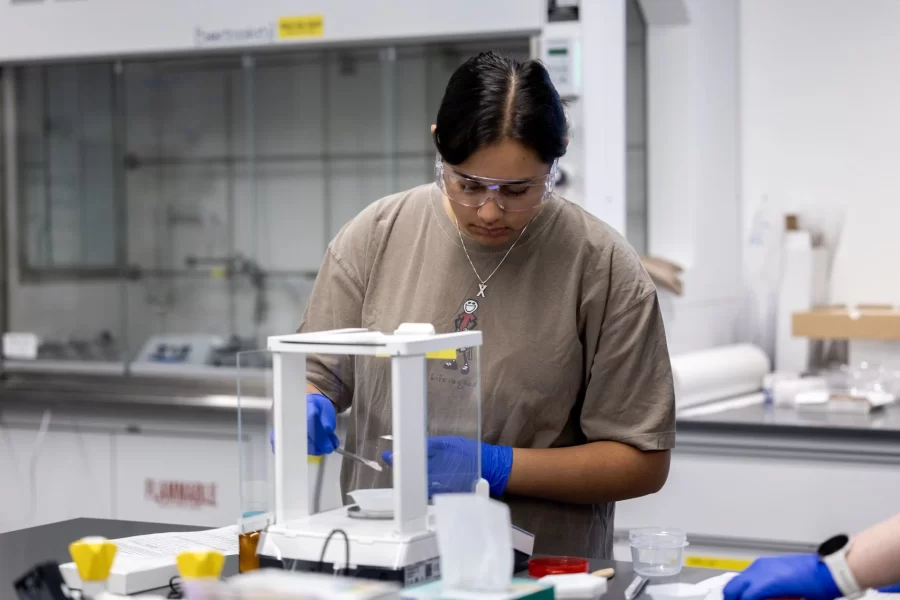
They are jumping for joy. Women’s varsity rowing teammates Oli Seline ’24 (left) of Delaware, Ohio, and Olivia Dekker ’24 of Bethesda, Md., high five it at the conclusion of their last-ever Bates lab in Bonney 360. The teammates are students in Assistant Professor of Biochemistry Geneva Laurita’s Short Term course, “Chemistry and the Arts.” Seline is a biochemistry major with a GEC in “Visible Ideas,” while Dekker is a biochemistry major with a minor in art and visual culture. The course explores the connection between chemistry and various topics in the arts and arts-related fields. The students learn about the chemistry behind these topics, exploring the literature behind various artistic practices, and applying hands-on techniques in the laboratory involved in various art processes This year, Laurita asked students to focus on the origins of color, different crafts, print making, jewelry making, dyeing, and art conservation. Laurita is the recipient of a major National Science Foundation grant of $581,984. The NSF CAREER award, considered to be one of the foundation’s most prestigious awards for faculty members who are just beginning their teaching and research careers, is based on both her scientific research in solid state materials and how she brings undergraduates into that vital area of scientific exploration. 3:18 What the particular lab was about…the lab handout. Kate Baumler, intern for Geneva’s NSF grant, wearing, black shirt Benji Richards, ’27, wearing tan shirt Finian Gunny ’27, gray pullover and blond hair Charlotte Maffie ’25 with pink tie dyed and hair in bun Sister Alice Maffie ’27 in t-shirt and pony tail Nina Greeley ’24 with hair in bun and pink t-shirt Riley Lund ’26 in gray sweatshirt Jahan Baker-Wainwright ’25 in green golf Rohini Kandasamy ’27 in dark tan Life is cool t-shirt and low bun Chemistry and the Arts S28, the origin of different crafts, print making, jewelry making, dyeing and art soncserv
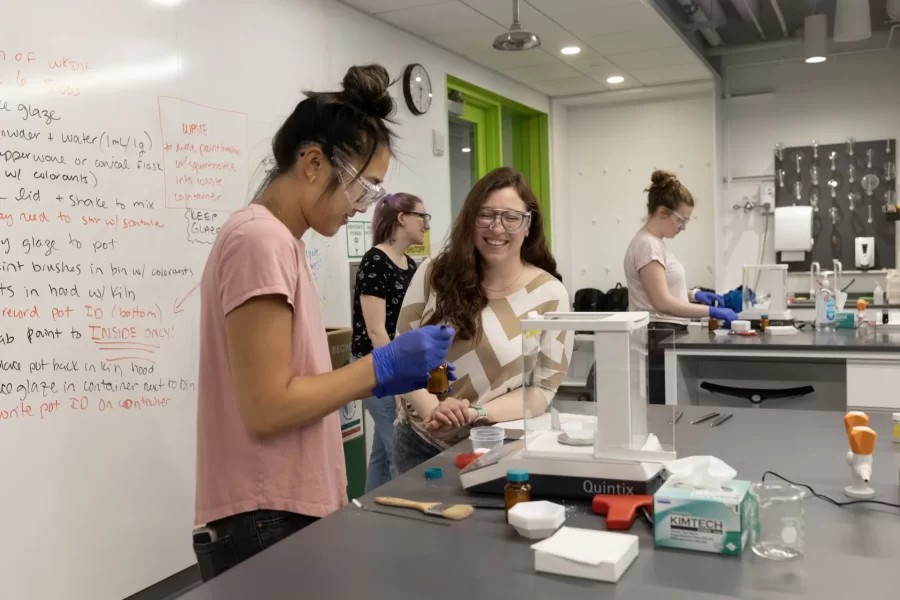
They are jumping for joy. Women’s varsity rowing teammates Oli Seline ’24 (left) of Delaware, Ohio, and Olivia Dekker ’24 of Bethesda, Md., high five it at the conclusion of their last-ever Bates lab in Bonney 360. The teammates are students in Assistant Professor of Biochemistry Geneva Laurita’s Short Term course, “Chemistry and the Arts.” Seline is a biochemistry major with a GEC in “Visible Ideas,” while Dekker is a biochemistry major with a minor in art and visual culture. The course explores the connection between chemistry and various topics in the arts and arts-related fields. The students learn about the chemistry behind these topics, exploring the literature behind various artistic practices, and applying hands-on techniques in the laboratory involved in various art processes This year, Laurita asked students to focus on the origins of color, different crafts, print making, jewelry making, dyeing, and art conservation. Laurita is the recipient of a major National Science Foundation grant of $581,984. The NSF CAREER award, considered to be one of the foundation’s most prestigious awards for faculty members who are just beginning their teaching and research careers, is based on both her scientific research in solid state materials and how she brings undergraduates into that vital area of scientific exploration. 3:18 What the particular lab was about…the lab handout. Kate Baumler, intern for Geneva’s NSF grant, wearing, black shirt Benji Richards, ’27, wearing tan shirt Finian Gunny ’27, gray pullover and blond hair Charlotte Maffie ’25 with pink tie dyed and hair in bun Sister Alice Maffie ’27 in t-shirt and pony tail Nina Greeley ’24 with hair in bun and pink t-shirt Riley Lund ’26 in gray sweatshirt Jahan Baker-Wainwright ’25 in green golf Rohini Kandasamy ’27 in dark tan Life is cool t-shirt and low bun Chemistry and the Arts S28, the origin of different crafts, print making, jewelry making, dyeing and art soncserv
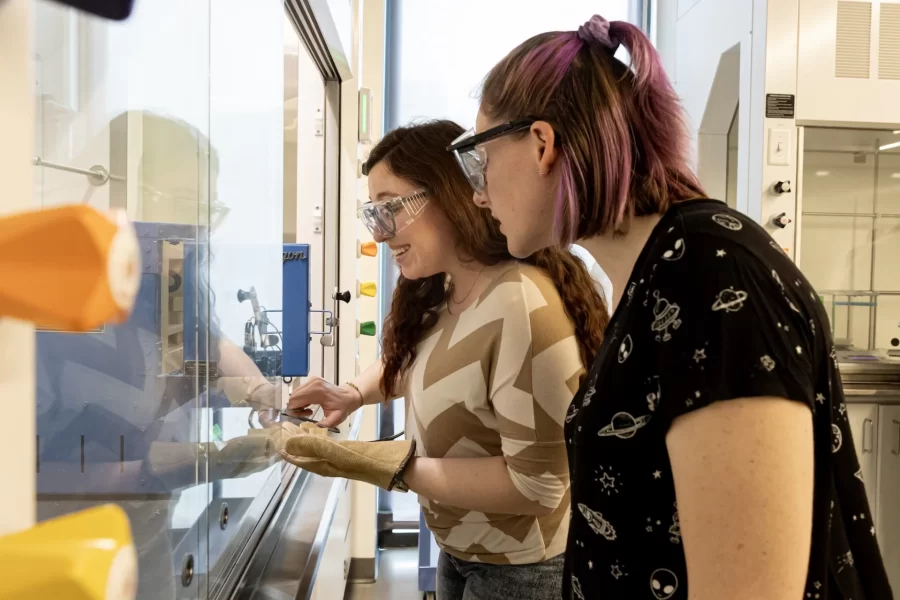
They are jumping for joy. Women’s varsity rowing teammates Oli Seline ’24 (left) of Delaware, Ohio, and Olivia Dekker ’24 of Bethesda, Md., high five it at the conclusion of their last-ever Bates lab in Bonney 360. The teammates are students in Assistant Professor of Biochemistry Geneva Laurita’s Short Term course, “Chemistry and the Arts.” Seline is a biochemistry major with a GEC in “Visible Ideas,” while Dekker is a biochemistry major with a minor in art and visual culture. The course explores the connection between chemistry and various topics in the arts and arts-related fields. The students learn about the chemistry behind these topics, exploring the literature behind various artistic practices, and applying hands-on techniques in the laboratory involved in various art processes This year, Laurita asked students to focus on the origins of color, different crafts, print making, jewelry making, dyeing, and art conservation. Laurita is the recipient of a major National Science Foundation grant of $581,984. The NSF CAREER award, considered to be one of the foundation’s most prestigious awards for faculty members who are just beginning their teaching and research careers, is based on both her scientific research in solid state materials and how she brings undergraduates into that vital area of scientific exploration. 3:18 What the particular lab was about…the lab handout. Kate Baumler, intern for Geneva’s NSF grant, wearing, black shirt Benji Richards, ’27, wearing tan shirt Finian Gunny ’27, gray pullover and blond hair Charlotte Maffie ’25 with pink tie dyed and hair in bun Sister Alice Maffie ’27 in t-shirt and pony tail Nina Greeley ’24 with hair in bun and pink t-shirt Riley Lund ’26 in gray sweatshirt Jahan Baker-Wainwright ’25 in green golf Rohini Kandasamy ’27 in dark tan Life is cool t-shirt and low bun Chemistry and the Arts S28, the origin of different crafts, print making, jewelry making, dyeing and art soncserv
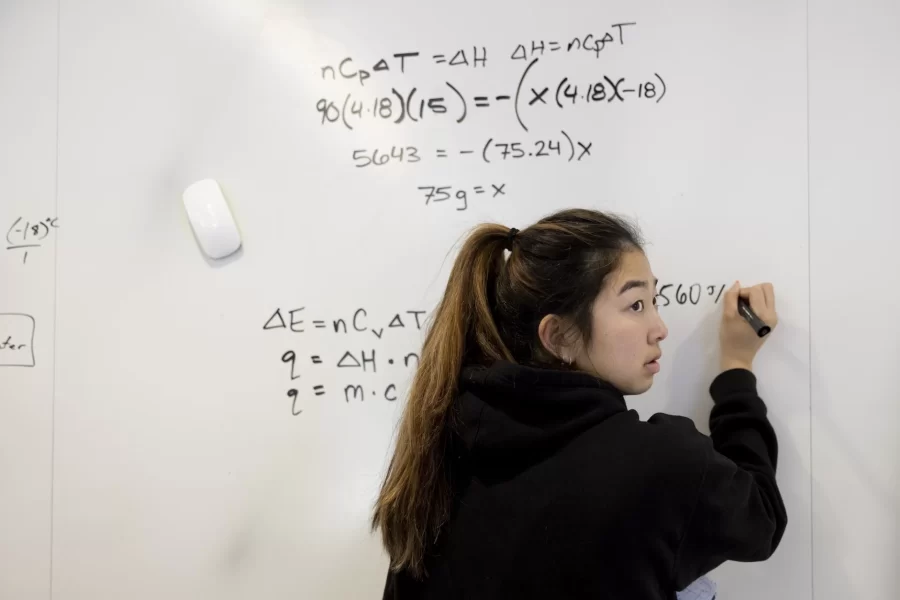
Assistant Professor of Chemistry Geneva Laurita teaches CHEM 108A – Chemical Reactivity/Lab on Monday, Jan. 30, 2023. A continuation of CHEM 107A. Major topics include thermodynamics, kinetics, equilibrium, acid/base behavior, and electrochemistry. Laboratory: three hours per week.
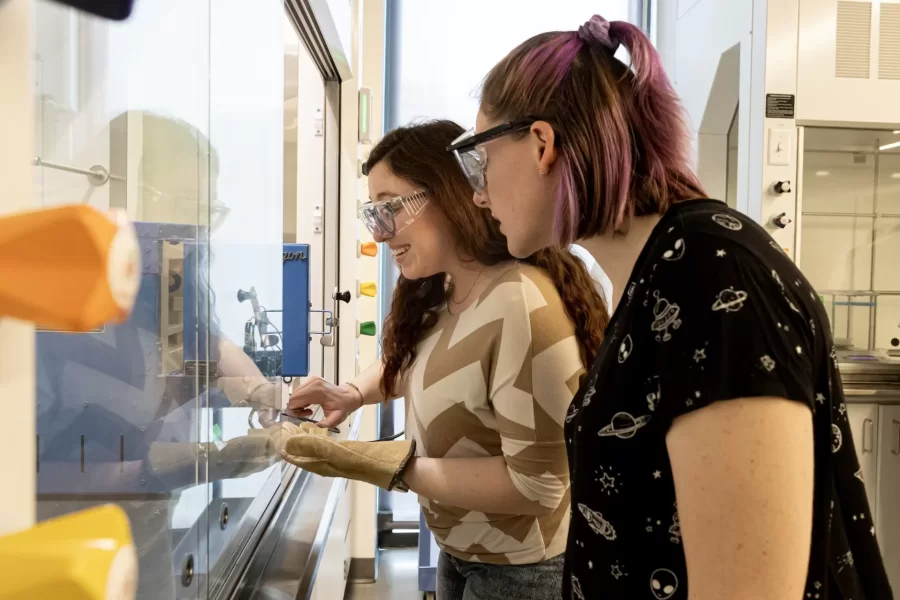
They are jumping for joy. Women’s varsity rowing teammates Oli Seline ’24 (left) of Delaware, Ohio, and Olivia Dekker ’24 of Bethesda, Md., high five it at the conclusion of their last-ever Bates lab in Bonney 360. The teammates are students in Assistant Professor of Biochemistry Geneva Laurita’s Short Term course, “Chemistry and the Arts.” Seline is a biochemistry major with a GEC in “Visible Ideas,” while Dekker is a biochemistry major with a minor in art and visual culture. The course explores the connection between chemistry and various topics in the arts and arts-related fields. The students learn about the chemistry behind these topics, exploring the literature behind various artistic practices, and applying hands-on techniques in the laboratory involved in various art processes This year, Laurita asked students to focus on the origins of color, different crafts, print making, jewelry making, dyeing, and art conservation. Laurita is the recipient of a major National Science Foundation grant of $581,984. The NSF CAREER award, considered to be one of the foundation’s most prestigious awards for faculty members who are just beginning their teaching and research careers, is based on both her scientific research in solid state materials and how she brings undergraduates into that vital area of scientific exploration. 3:18 What the particular lab was about…the lab handout. Kate Baumler, intern for Geneva’s NSF grant, wearing, black shirt Benji Richards, ’27, wearing tan shirt Finian Gunny ’27, gray pullover and blond hair Charlotte Maffie ’25 with pink tie dyed and hair in bun Sister Alice Maffie ’27 in t-shirt and pony tail Nina Greeley ’24 with hair in bun and pink t-shirt Riley Lund ’26 in gray sweatshirt Jahan Baker-Wainwright ’25 in green golf Rohini Kandasamy ’27 in dark tan Life is cool t-shirt and low bun Chemistry and the Arts S28, the origin of different crafts, print making, jewelry making, dyeing and art soncserv
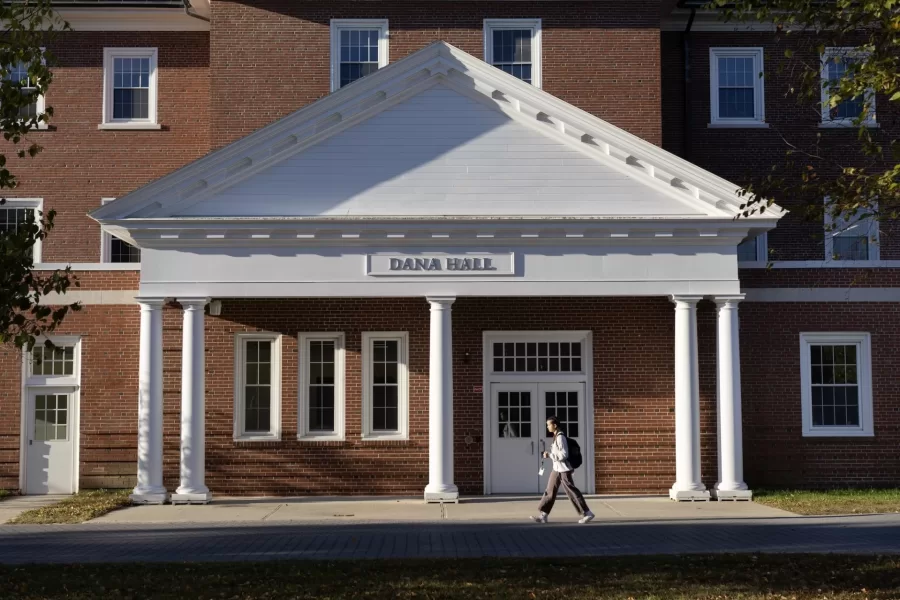
Campus scenes from Oct. 11, 2024. Students pass by Dana Chemistry on Alumni Walk.
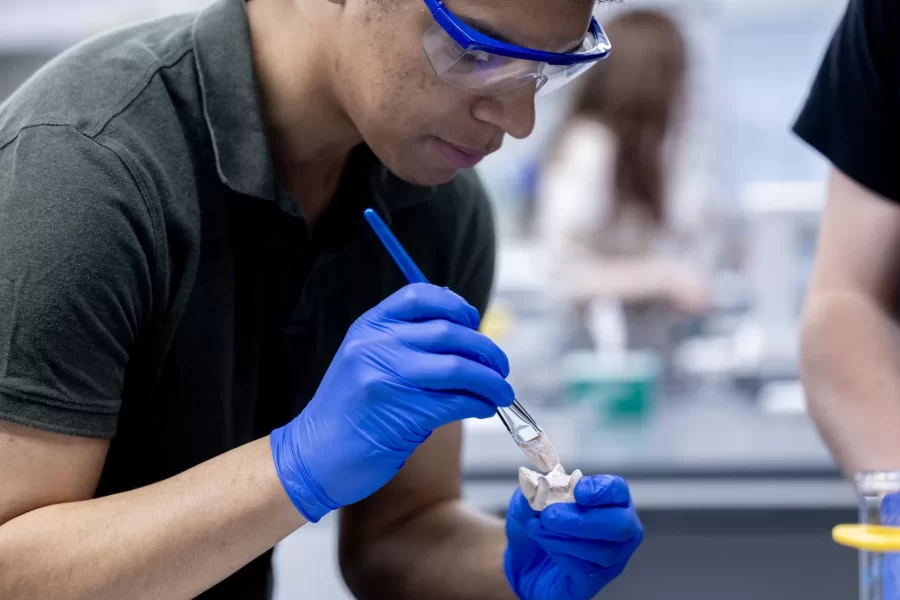
They are jumping for joy. Women’s varsity rowing teammates Oli Seline ’24 (left) of Delaware, Ohio, and Olivia Dekker ’24 of Bethesda, Md., high five it at the conclusion of their last-ever Bates lab in Bonney 360. The teammates are students in Assistant Professor of Biochemistry Geneva Laurita’s Short Term course, “Chemistry and the Arts.” Seline is a biochemistry major with a GEC in “Visible Ideas,” while Dekker is a biochemistry major with a minor in art and visual culture. The course explores the connection between chemistry and various topics in the arts and arts-related fields. The students learn about the chemistry behind these topics, exploring the literature behind various artistic practices, and applying hands-on techniques in the laboratory involved in various art processes This year, Laurita asked students to focus on the origins of color, different crafts, print making, jewelry making, dyeing, and art conservation. Laurita is the recipient of a major National Science Foundation grant of $581,984. The NSF CAREER award, considered to be one of the foundation’s most prestigious awards for faculty members who are just beginning their teaching and research careers, is based on both her scientific research in solid state materials and how she brings undergraduates into that vital area of scientific exploration. 3:18 What the particular lab was about…the lab handout. Kate Baumler, intern for Geneva’s NSF grant, wearing, black shirt Benji Richards, ’27, wearing tan shirt Finian Gunny ’27, gray pullover and blond hair Charlotte Maffie ’25 with pink tie dyed and hair in bun Sister Alice Maffie ’27 in t-shirt and pony tail Nina Greeley ’24 with hair in bun and pink t-shirt Riley Lund ’26 in gray sweatshirt Jahan Baker-Wainwright ’25 in green golf Rohini Kandasamy ’27 in dark tan Life is cool t-shirt and low bun Chemistry and the Arts S28, the origin of different crafts, print making, jewelry making, dyeing and art soncserv
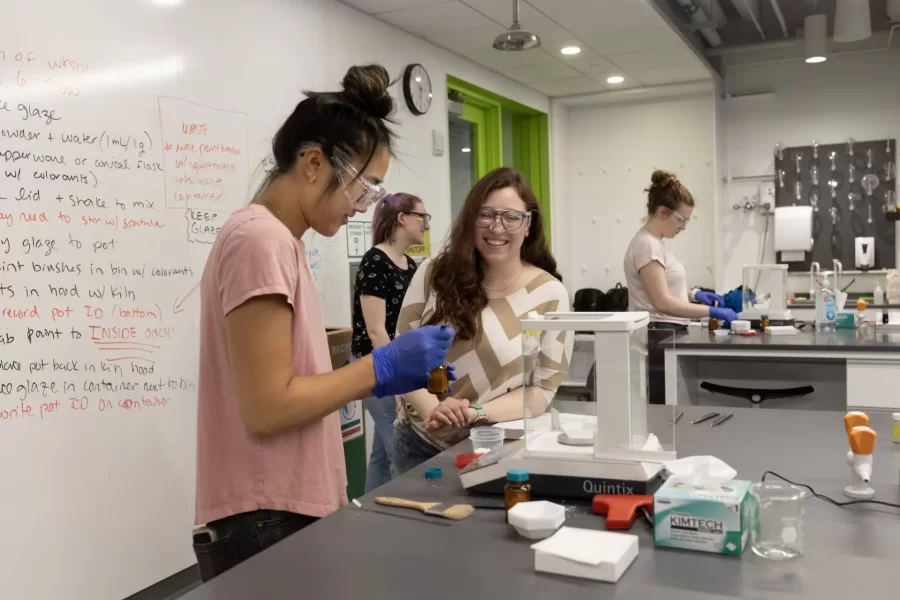
They are jumping for joy. Women’s varsity rowing teammates Oli Seline ’24 (left) of Delaware, Ohio, and Olivia Dekker ’24 of Bethesda, Md., high five it at the conclusion of their last-ever Bates lab in Bonney 360. The teammates are students in Assistant Professor of Biochemistry Geneva Laurita’s Short Term course, “Chemistry and the Arts.” Seline is a biochemistry major with a GEC in “Visible Ideas,” while Dekker is a biochemistry major with a minor in art and visual culture. The course explores the connection between chemistry and various topics in the arts and arts-related fields. The students learn about the chemistry behind these topics, exploring the literature behind various artistic practices, and applying hands-on techniques in the laboratory involved in various art processes This year, Laurita asked students to focus on the origins of color, different crafts, print making, jewelry making, dyeing, and art conservation. Laurita is the recipient of a major National Science Foundation grant of $581,984. The NSF CAREER award, considered to be one of the foundation’s most prestigious awards for faculty members who are just beginning their teaching and research careers, is based on both her scientific research in solid state materials and how she brings undergraduates into that vital area of scientific exploration. 3:18 What the particular lab was about…the lab handout. Kate Baumler, intern for Geneva’s NSF grant, wearing, black shirt Benji Richards, ’27, wearing tan shirt Finian Gunny ’27, gray pullover and blond hair Charlotte Maffie ’25 with pink tie dyed and hair in bun Sister Alice Maffie ’27 in t-shirt and pony tail Nina Greeley ’24 with hair in bun and pink t-shirt Riley Lund ’26 in gray sweatshirt Jahan Baker-Wainwright ’25 in green golf Rohini Kandasamy ’27 in dark tan Life is cool t-shirt and low bun Chemistry and the Arts S28, the origin of different crafts, print making, jewelry making, dyeing and art soncserv
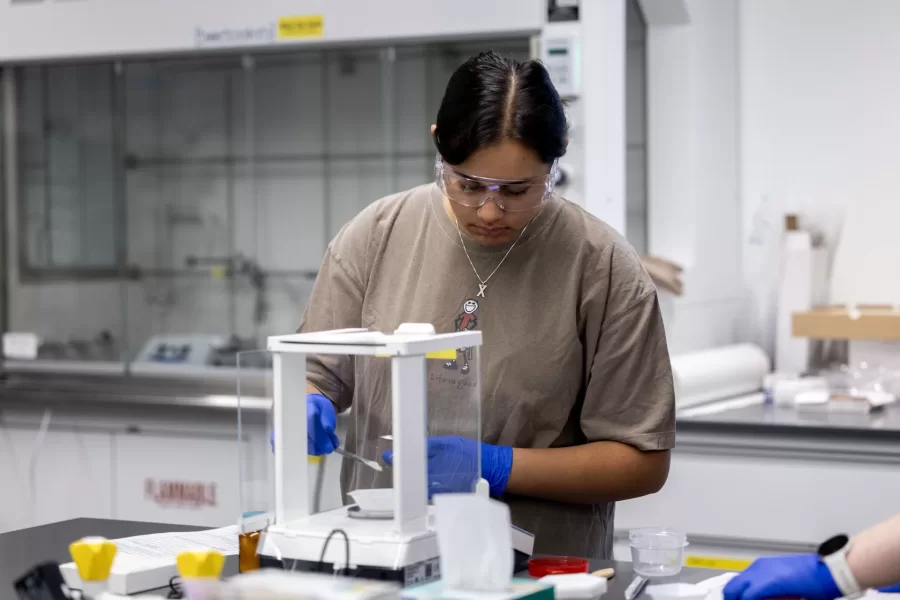
They are jumping for joy. Women’s varsity rowing teammates Oli Seline ’24 (left) of Delaware, Ohio, and Olivia Dekker ’24 of Bethesda, Md., high five it at the conclusion of their last-ever Bates lab in Bonney 360. The teammates are students in Assistant Professor of Biochemistry Geneva Laurita’s Short Term course, “Chemistry and the Arts.” Seline is a biochemistry major with a GEC in “Visible Ideas,” while Dekker is a biochemistry major with a minor in art and visual culture. The course explores the connection between chemistry and various topics in the arts and arts-related fields. The students learn about the chemistry behind these topics, exploring the literature behind various artistic practices, and applying hands-on techniques in the laboratory involved in various art processes This year, Laurita asked students to focus on the origins of color, different crafts, print making, jewelry making, dyeing, and art conservation. Laurita is the recipient of a major National Science Foundation grant of $581,984. The NSF CAREER award, considered to be one of the foundation’s most prestigious awards for faculty members who are just beginning their teaching and research careers, is based on both her scientific research in solid state materials and how she brings undergraduates into that vital area of scientific exploration. 3:18 What the particular lab was about…the lab handout. Kate Baumler, intern for Geneva’s NSF grant, wearing, black shirt Benji Richards, ’27, wearing tan shirt Finian Gunny ’27, gray pullover and blond hair Charlotte Maffie ’25 with pink tie dyed and hair in bun Sister Alice Maffie ’27 in t-shirt and pony tail Nina Greeley ’24 with hair in bun and pink t-shirt Riley Lund ’26 in gray sweatshirt Jahan Baker-Wainwright ’25 in green golf Rohini Kandasamy ’27 in dark tan Life is cool t-shirt and low bun Chemistry and the Arts S28, the origin of different crafts, print making, jewelry making, dyeing and art soncserv
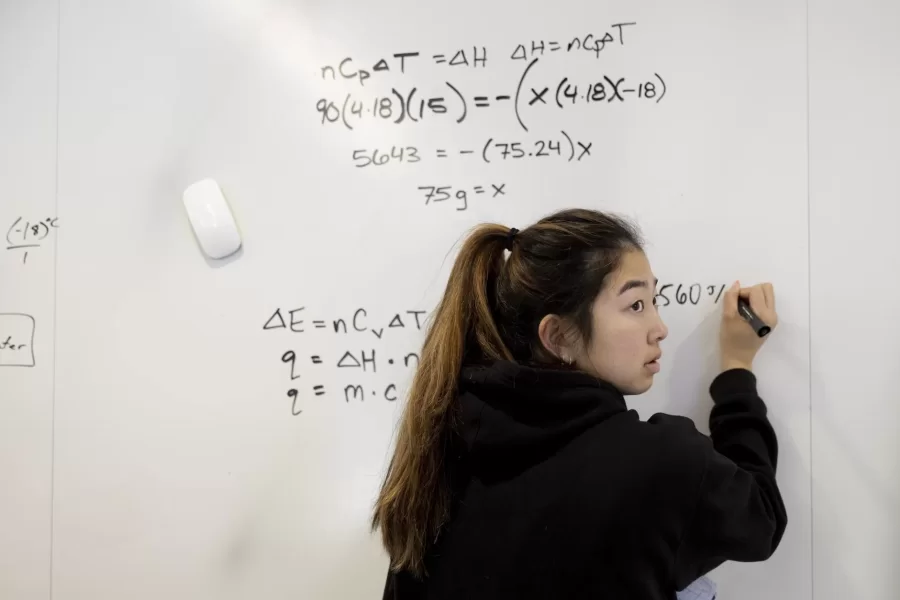
Assistant Professor of Chemistry Geneva Laurita teaches CHEM 108A – Chemical Reactivity/Lab on Monday, Jan. 30, 2023. A continuation of CHEM 107A. Major topics include thermodynamics, kinetics, equilibrium, acid/base behavior, and electrochemistry. Laboratory: three hours per week.
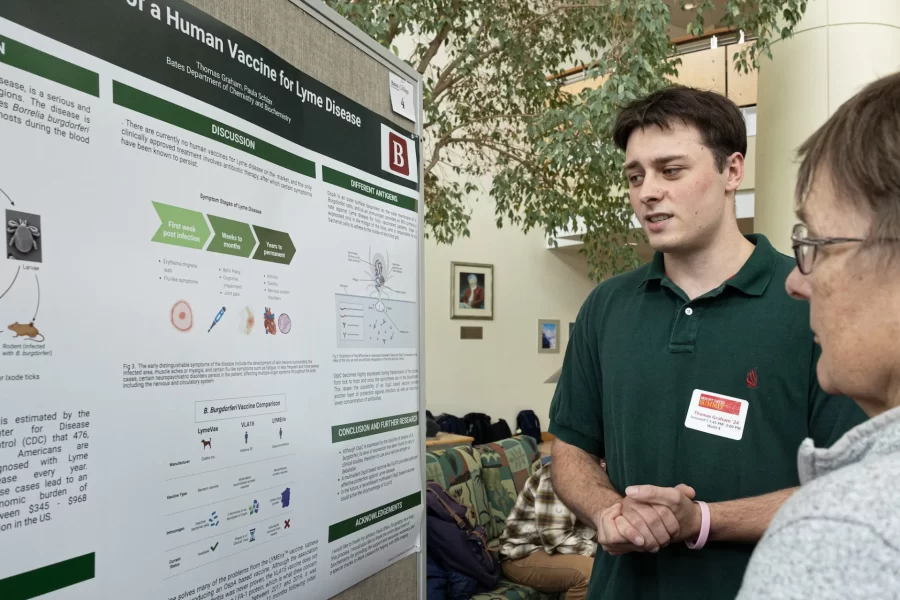
It’s quintessential Bates as the college community shows the power of love in supporting students and their academic achievements at Mount David Summit. Friday, April 5, 2024 in Pettengill Hall.
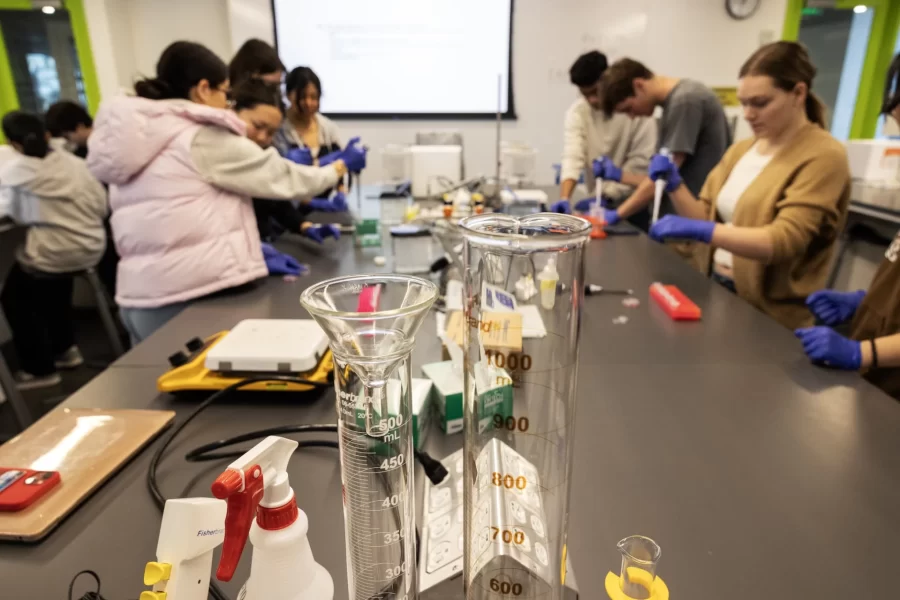
Moments from Lab-Based Biological Inquiry Cellular Neuroscience taught by Martin Kruse, associate professor of biology and neuroscience, in Bonney Science Center Room 370 on January 25, 2024. (Theophil Syslo | Bates College)